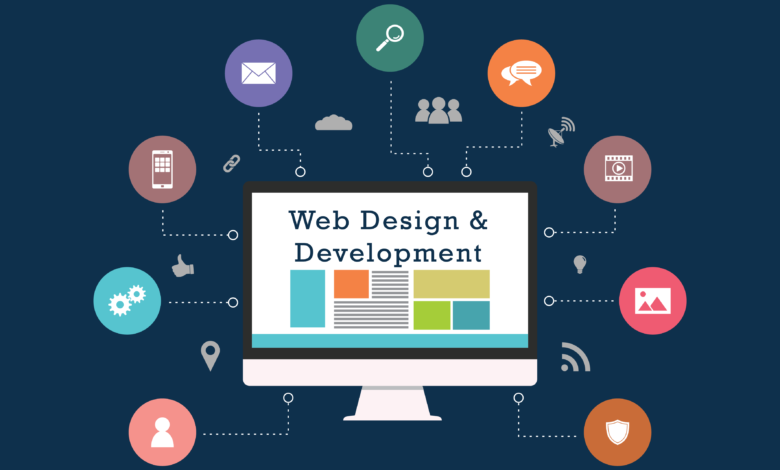
When I’m on the internet I browse through hundreds of pages every day. Although I’m often able to recall interesting facts from my online browsing.
However, the sites themselves aren’t able to stay in my mind for long. But, there are some exceptions. If I see pages that have solid design and fluid UX I will be able to will remember those sites.
“Keeping in touch with web development trends is becoming increasingly important to ensure a secure, functionally competitive, and user-friendly website. Failing to keep up with recent trends can seriously affect your website performance and user experience. As a result, your traffic will dip.”
You may be shocked to learn that numerous web development trends have already been established. They’ll get more popular over the next few years and therefore, implementing the best practices for web development is more important than ever. Let’s examine the trends in web development in 2024 to watch out for.
Web Development Trends for 2024
1. Progressive Web Apps (PWAs)
Although progressive web applications (PWAs) aren’t completely new, however, the latest version of them is set to replace web-based apps to make a difference. PWAs aid websites to load quickly and also work offline in applications such as Google Maps. Some companies like Starbucks, Uber, Pinterest and Twitter make use of PWAs to provide a better user experience. in 2024, many other companies will be able to benefit from this technology.
In the final period of the 2023 quarter, nearly 58% of all international traffic on the internet came from mobile devices (not including tablets). With the increasing use of tablets and smartphones to complete different internet-related tasks, it’s never been more important to transform web applications into PWAs.
Apart from providing a superior user experience, PWAs also provide advantages such as lower cost of developing websites and effortless maintenance for the service provider. They also appear and function just like regular websites.
The year 2024 is when HTML, CSS, JavaScript, React, WebAssembly as well as Angular are expected to be utilized in 2024 when it comes time to create PWAs. Web developers are adopting PWA concepts to offer reliable and enjoyable user experiences.
Additionally, many modern frameworks have the basic PWA configurations, or other packages which convert an application to the format of a PWA. They can help to create the creation of a new PWA project as well as to introduce new files into an existing project.
My opinion: I like PWAs due to their speedy loading times. If I’m visiting a website that takes a long time for it to open, I’ll usually look for a different alternative. This is particularly applicable when I’m constantly travelling, and trying to accomplish tasks in a hurry when I’m on the move.
2. AI Chatbots & More
In the findings of our AI trends report 62 percent of business executives have already made investments in AI technology for their employees. Of these executives, 71% of them are anticipating an increase in ROI.
The year 2024 will be the time when AI chatbots can become more advanced to cater to the needs of users. To achieve this, bots can more effectively match users’ needs by using machine learning natural language processing and information retrieval methods.
Apart from helping businesses perform more efficiently through text or voice chats, AI-enabled chatbots can also improve the user experience. The chatbot can be used as the AI chatbot to gather data respond to frequently asked questions, and resolve other issues. The result is an effortless digital experience that users can delight in.
This is the reason AI will be integrated into the business world by 2024. Alternatively, you can utilize AI tools such as GitHub Copilot to review and write the code of your website. The survey by StackOverflow in 2023 revealed that 77% of those who responded planning to use AI tools to aid in the development of their website.
There’s also a growing trend of making use of AI as well as machine-learning algorithms to anticipate user behaviour. This is typically used to create prevention measures to avoid future errors.
My suggestion is if your website has a customer service aspect I would highly suggest incorporating chatbots on your site even if the chatbot only directs customers to a live person. Why? Being able to communicate instantly reduces the frustration of customers when faced with a dilemma.
I made a booking with United and was required to change my travel plans. I needed to make the change as soon as possible but could not make the switch on a web page. Chatbots helped me get directed to the correct person and informed me of the time I’d need to wait before connecting with the rep. Knowing the time I would wait instead of waiting by phone was a big difference to me.
3. Accelerated Mobile Pages
Nearly 70% of customers have said that speed affects the choice to purchase from an online store According to Unbounce. Also, it is important to consider your website’s speed. This is where mobile-friendly pages that are speedy become an issue.
It was first introduced by Google in the year 2015 The accelerated mobile page (AMP) offers mobile users with super-fast digital experiences. Alongside offering seamless user experiences, and reducing bounce rate, Google’s AMP could increase the effectiveness of the fundamental business metrics. These metrics could be as crucial as the amount of conversions that occur on websites.
Although AMP utilization has been declining since 2020, it is the most used mobile technology in the world and is used on more than 45 per cent of websites using mobile technology and more than 50% of the most popular 10,000 websites.
With AMP Playground it is possible to cut and paste the AMP HTML codes to see how your pages will appear on various mobile devices before adding them to your website. Be sure to add your unique AMP canonical tag to ensure that you differentiate your AMP and non-AMP versions to Google.
Note: If you reside in Surat and are interested in pursuing offline courses, DecodeX Infotech offers a Web Development Company in Surat, where you can learn web development and enhance your skills.
4. Single-Page Applications
As one of the most important new trends in web development Single-page apps (SPAs) comprise JavaScript web apps that display one HTML page in a user’s browser and update the content as required and without having to refresh the webpage.
The development community as well as Google, Facebook, and Twitter have embraced SPAs. Because people can access the website without having to load a completely fresh page on the servers, overall performance is far superior. Although there is more work involved in the maintenance of SPAs. However, it is more than worth the sacrifice.
Apart from being cost-effective and simple to design due to the well-known AngularJS framework. SPAs take up smaller amounts of server resources and give users information in a single location without having to move through. This makes SPAs an ideal solution for developers as well as site visitors.
Since online users are demanding a more speedy and simple experience on their mobile devices We are likely to see to see the SPA trends keep going over the next year.
It is important to keep in mind that SPAs use one, unique consistent resource locator (URL) and utilize JavaScript and JavaScript, which means they’ll be difficult to rank SEO rankings. This means that they’re a great design option if you’re planning on making use of them for social media such as Facebook, SaaS applications, and closed communities.
My thoughts: I am not a fan of refreshing websites. This could be due to my experience of making changes to HTML for blog entries, and then having to refresh the page to see the changes. If I could reduce the amount of time I refresh, I’d be more content, which is the reason I am a fan of SPAs.
5. Optimized Voice Search
The first time voice search was introduced in the form of Google in 2011 voice search was quickly gaining popularity. Intelligent virtual assistants such as Alexa or Siri have witnessed massive market growth over the last couple of years, and are expected to increase in speed according to an analysis from Grand View Research.
According to Google According to Google, 27% of users make use of voice search capabilities via mobile devices. GlobeNewswire says that 50 percent of Americans make use of voice search every day at least and more than 1 billion voice searches happen each month.
The tech giants are increasingly making their debuts or launching new products, such as Google Home or Apple HomePod to meet the demands of consumers. Over half of the adults living in the United States have a smart home appliance, as well. This means that voice search is expected to become more popular than ever before.
Consumers aren’t only using smart speakers to conduct voice searches, they’re also using smartphones as well as IoT devices. So, in other words, voice search results will begin to appear more frequently and higher on search results pages. Therefore, businesses are working to optimize their offerings and strategy of content for voice searches by 2024.
In this instance, Natural Language Processing (NLP) is getting better at helping voice search assistants understand and respond to increasingly complex requests.
Therefore, if you’re employing other tools for keyword research to enhance voice search, NLP should also be included in your toolbox. It means that voice search tools can understand complex questions and create personalized advertisements based on their understanding.
My view is that I make use of voice search every day particularly when I’m looking for YouTube content on the television. Voice search allows me to find information more quickly and hands-free, which makes it among my most-loved trends in this list.
6. WordPress Development
WordPress CMS WordPress CMS powers over 43 per cent of all websites, and it is a major presence that demands attention. It is an open source system, and WordPress continually adds more features to satisfy users’ demands. There are a lot of specific WordPress web development trends and it’s worthwhile to explore these.
2024 will also witness significant growth in the use of Headless WordPress, a decoupled structure that separates the front and back end. This way, you will be able to utilize different front-end technology and still utilize WordPress’s powerful capabilities for managing content. This library, called React JavaScript or Angular library is a great option in the process of making an entirely headless CMS.
My thoughts: The recent changes to WordPress can have a significant impact on websites because most of the web makes use of the CMS. If you want to remain at the forefront be aware of the changes WordPress is up to and see what modifications you would like to reflect on your website.
7. Motion UI
Consumers today don’t just expect more mobile-friendly and faster digital experiences. They also want more immersive and interactive ones.
This is the reason Motion UI is now extremely famous. Motion UI is a front-end framework that permits developers to create fully responsive mobile and web applications, and also to utilize predefined motions in the native app settings. With the framework, you can create an element move, spin, slide as well as transitions.
Motion UI is also a great option because it is compatible with all web technologies and can be integrated into any website. Some of the most popular locations to incorporate Motion UI are the header menu, footer, and header. Although this framework gained traction in 2018it is now more accessible due to its SASS libraries’ capabilities and has become one of the top web development trends for 2024.
Consider making use of UI frameworks such as Material Design, JavaScript libraries such as Anime.js along with CSS animations to create interactive and user-friendly interfaces. Motion UI enhances user experience by providing information that is pleasing to the eye.
My thoughts: A more movement on a site keeps me glued. In reality, very few people are adding these kinds of motions to their websites and it’s a great method to be noticed.
8. Serverless Architecture
There’s been a continuous look for technology that can help minimize system overloading as well as data loss along with development costs. This is the serverless technology.
Serverless architecture is based using cloud technology. It lets users execute code for almost any kind of application or backend service, with no administrative burden. There is no need to provision, manage or re-upgrading servers is required. Amazon, Google, and Microsoft are the top companies offering serverless architecture.
The market for serverless architecture is estimated at $36.84 billion by 2022. We can anticipate more companies to enter the market in 2024 and later.
We’ll also see a variety of applications — such as chatbots and IoT applications, APIs and more — that utilize serverless functions to accomplish tasks like downloading backups of files sending notifications, as well as exporting objects.
My suggestion If you’re concerned about security issues, recommend breaking up your environment and connecting them to distinct AWS accounts. This allows you to keep data safe, particularly when an environment is accidentally deleted. It also ensures that there aren’t any premature rollouts.
9. No-Code/Low-Code Development
According to research conducted recently on the industry of low-code, it is predicted to earn more than 65 billion US dollars in 2027. By 2030, it’s estimated to reach $187 billion. This equates to an annual growth rate of 31.1 per cent.
We’re seeing an increase in development that is low-code or no-code in 2024, due to businesses seeking to speedily and effectively build unique and responsive websites without the need for developers.
Non-technical team members can try it out as it comes with a minimal learning curve. Developers use these platforms to develop the initial stage and later expand it. This makes it easy to use and will help your team to be more productive.
10. Dark Mode Standardization
In recent years, low-light and dark websites have seen a surge in popularity. One of the most popular trending topics has been the apps and websites that continue to provide users with dark-mode user interfaces (UIs) because studies have revealed that 8 per cent of users prefer using dark mode as often as they can.
Facebook Twitter and Facebook Twitter have already adopted this feature. Both apps give users an alternative to switch between two modes based on the preferences of the user or the system’s preferences. The art of personalizing your website is vital since visitors want an entirely customized experience, so make certain that you fulfil the promise.
As more web developers offer an integrated feature that lets users change between dark and light modes, it will be the norm by 2024 or later. It could be the standard for apps.
Are you unsure if you’ve created your Dark Mode properly, especially for people with disabilities? Check out the Web Content Accessibility Guidelines (WCAG) contrast ratio tester. The chart for compliance will help you make sure that your experience as a user in Dark Mode isn’t hampered.
My opinion is that I’m an avid Dark Mode user. It’s the default setting on both my laptop and phone and also my default style for most websites. If your website offers Dark Mode, I’m switching to it. There are plenty of users similar to me that you should consider making Dark Mode an option.
11. Improved Native Cybersecurity
Cybersecurity is the term used to describe the process of protecting networks, data and computers from misuse is among the biggest concerns of 2024. Any business, regardless of its size, is susceptible. This year, for instance streaming service Roku was hit with a massive information breach in April which affected around 56,000 accounts.
Based on the CDN provider Cloudflare Cloudflare, the number of distributed denial-of-service (DDoS) attacks that they thwarted increased by 85% between 2022 and 2023 in comparison to 2022. The time it takes to fix a problem, the loss of revenue, as well as an unpopular reputation are only some of the consequences of this kind of attack.
In the wake of such a dramatic increase in cybercrimes, the development of websites has been redesigned to help protect customer and company information. There’s been a move towards application-based multi-factor authentication such as Google Authenticator, patch management as well as Security Operation Centers (SOC).
We’ll continue to see an increase in the use of non-traditional strategies to enhance security beyond analytics tools and monitoring checkpoints.
Danny Wajcman, co-founder and COO of the company that makes heat mapping software and live chat firm Lucky Orange, notes the importance of monitoring by humans as well as automatization: “We firmly believe session recordings can help identify security issues like a DDoS attack or extreme bot traffic…Having a feel for your daily traffic trends and regularly following visitor journeys builds your ability to recognize when something isn’t quite right.”
The best method to stay current on the latest security threats is to check the latest OWASP list. When you have identified typical issues that may occur use the tools for vulnerability analysis to remain vigilant.
My view: I think most people don’t think about security every time they’re on the internet. But, they’ll be concerned should there be a security breach, and their data be in danger. Upgrading your security is, according to me one of the best methods of retaining your users’ confidence.



